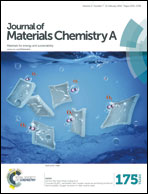YCuTe2: a member of a new class of thermoelectric materials with CuTe4-based layered structure†
Abstract
Intrinsically doped samples of YCuTe2 were prepared by solid state reaction of the elements. Based on the differential scanning calorimetry and the high temperature X-ray diffraction analyses, YCuTe2 exhibits a first order phase transition at ∼440 K from a low-temperature-phase crystallizing in the space group P![[3 with combining macron]](https://www.rsc.org/images/entities/char_0033_0304.gif) m1 to a high-temperature-phase in P
m1 to a high-temperature-phase in P![[3 with combining macron]](https://www.rsc.org/images/entities/char_0033_0304.gif) . Above the phase transition temperature, partially ordered Cu atoms become completely disordered in the crystal structure. Small increases to the Cu content are observed to favour the formation of the high temperature phase. We find no indication of superionic Cu ions as for binary copper chalcogenides (e.g., Cu2Se or Cu2Te). All investigated samples exhibit very low thermal conductivities (as low as ∼0.5 W m−1 K−1 at 800 K) due to highly disordered Cu atoms. Electronic structure calculations are employed to better understand the high thermoelectric efficiency for YCuTe2. The maximum thermoelectric figure of merit, zT, is measured to be ∼0.75 at 780 K for Y0.96Cu1.08Te2, which is promising for mid-temperature thermoelectric applications.
. Above the phase transition temperature, partially ordered Cu atoms become completely disordered in the crystal structure. Small increases to the Cu content are observed to favour the formation of the high temperature phase. We find no indication of superionic Cu ions as for binary copper chalcogenides (e.g., Cu2Se or Cu2Te). All investigated samples exhibit very low thermal conductivities (as low as ∼0.5 W m−1 K−1 at 800 K) due to highly disordered Cu atoms. Electronic structure calculations are employed to better understand the high thermoelectric efficiency for YCuTe2. The maximum thermoelectric figure of merit, zT, is measured to be ∼0.75 at 780 K for Y0.96Cu1.08Te2, which is promising for mid-temperature thermoelectric applications.



 Please wait while we load your content...
Please wait while we load your content...